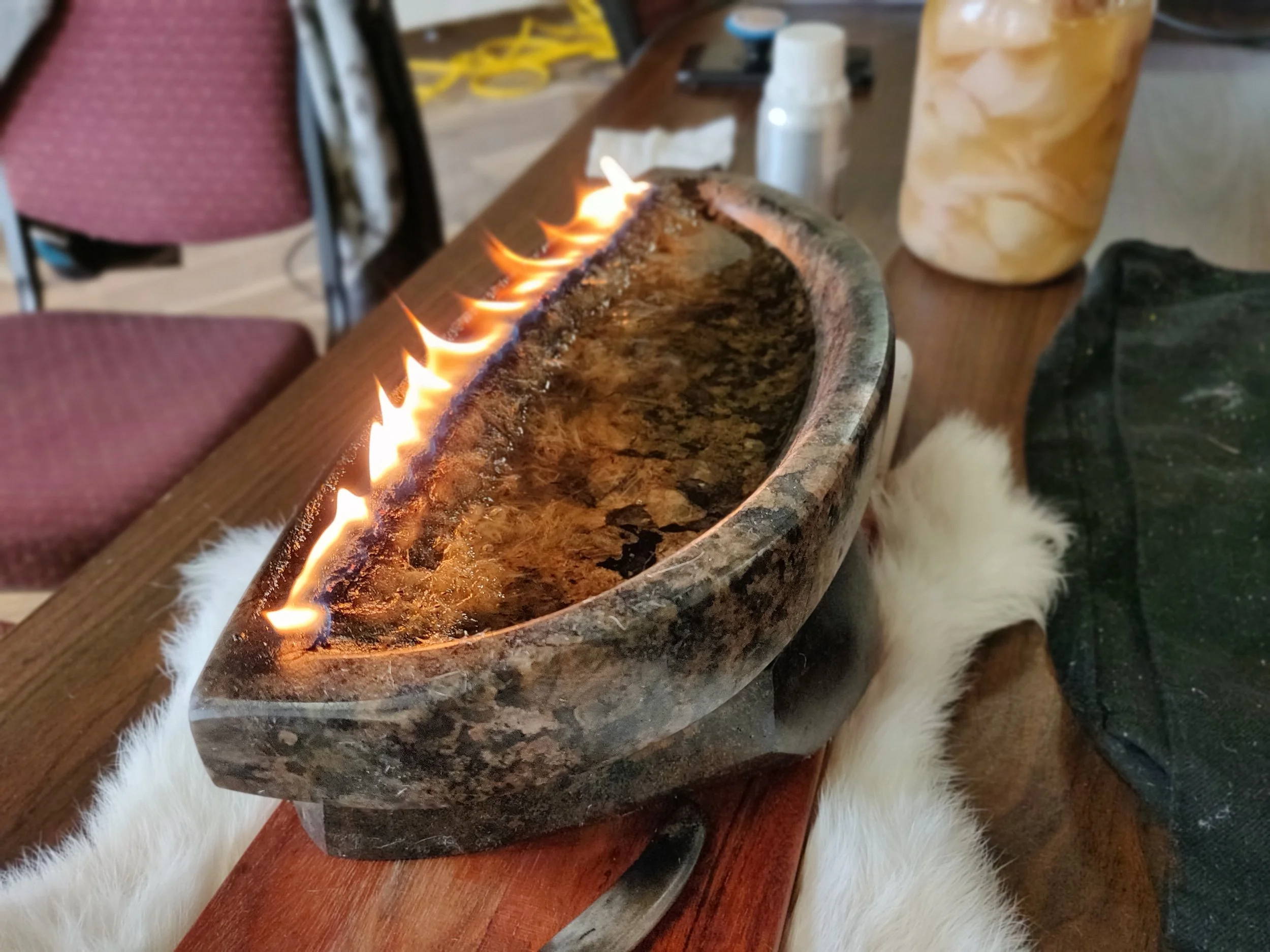How can I recognize National Indigenous Peoples Day?
June is National Indigenous History Month and National Indigenous Peoples Day (NIPD) is just under a week away – I am getting excited.
Full transparency: I am not Indigenous; I am a white settler and mother to an Inuk child. Since I became a mother to our son, June 21 has taken on a deeper significance. My partner and I strive to instill in our child an understanding and deep pride in his Inuit heritage; celebrating NIPD is one of the ways we can do that. I wanted to write this blog post for other non-Indigenous people who, like me, want to deepen their understanding of - and connection to - Indigenous peoples.
This qulliq (traditional oil lamp used by Inuit) was lit and tended to by Hovak Johnson at an Atelihai Inuit wellness gathering.
In case you are new to National Indigenous Peoples Day, this is “a day for all Canadians to recognize and celebrate the unique heritage, diverse cultures and outstanding contributions of First Nations, Inuit and Métis peoples.” NIPD recognizes the vibrancy and beauty of Indigenous cultures – it is a time when Indigenous folks celebrate and are celebrated. Sadly, for hundreds of years colonial powers actively destroyed and suppressed Indigenous cultural activities and languages; NIPD celebrates Indigeneity and many of these celebrations are open to non-Indigenous people. As a result, it is an important time for non-Indigenous people to honour Indigenous peoples and cultures by deepening our own understanding and appreciation.
In the last couple of weeks, I’ve brought up NIPD in conversation with non-Indigenous people in my community and I’ve learned that there is some confusion around the day. I’d like to take a shot at addressing two misconceptions:
1. As I understand it from Indigenous folks I know, National Indigenous Peoples Day is very different from the National Day for Truth and Reconciliation on September 30 (also known as Orange Shirt Day). Orange Shirt Day recognizes “the tragic legacy of residential schools, the missing children, the families left behind and the survivors of these institutions.” The National Day for Truth and Reconciliation is, in a sense, a day of mourning and a day when non-Indigenous Canadians can deepen their commitment to seek the truth about the harmful legacies of colonialism; NIPD, however, is a celebration of First Nations, Inuit, and Métis cultures.
2. Another misconception I’ve come across is: “Do I, as a non-Indigenous person, get to attend National Indigenous Peoples Day events? Is it appropriate for me to attend?” NIPD is meant to be a celebration that is open to all peoples. If the general public has been invited to attend, please do attend, but arrive with a tremendous amount of humility and be sure you follow any protocols that are shared with you. The invitation to share in these events should not be taken lightly; that said, don’t let your fear of getting something wrong stop you from celebrating this beautiful day.
If you would like to recognize and celebrate National Indigenous Peoples Day and you don’t know where to start, here are some suggestions:
Check out what celebrations are happening in your area for National Indigenous Peoples Day – attend with family, friends, neighbours, or colleagues. If the event is a Pow Wow here are some important dos and don’ts to be aware of.
Be sure you understand how to respectfully refer to Indigenous people. This two-and-a-half-minute video (made by Inuk journalist Ossie Michelin) is a great start for those of us living in what we now know as Canada.
If you live in an urban area, check out where your closest friendship centre is on this map. Friendship centres serve as community hubs for Indigenous folks in urban areas – maybe there might be some way you could connect with and/or contribute to your local friendship centre (please remember to move forward with humility).
Seek out courses to learn more about First Nations, Inuit, and/or Métis histories and cultures, so that we might better understand our responsibilities as treaty people. There are great free online classes such as the University of Alberta Indigenous Canada course and there are wonderful Indigenous-owned businesses that offer training as well, such as Indigenous Treaty Partners.
If you live in or near Kjipuktuk (Halifax), Dartmouth, or Millbrook First Nation (Mi’kma’ki / Nova Scotia) sign up to be a volunteer for the North American Indigenous Games: July 15 – 23, 2023.
Support Indigenous-owned businesses, large and small, near and far.
Watch a movie – or a short – made by and with Indigenous folks. Some of our favourite Indigenous movies are Smoke Signals (1998), Atanarjuat: The Fast Runner (2001), Angry Inuk (2016), and Kuessipan (2019, which can be found on CBC Gem). Also, here are some free Indigenous-made shorts on the National Film Board’s website.
If you don’t already know, visit this map to explore on whose lands you reside; commit to learning about these peoples and cultures (please also know that this map is an approximation of many different territories and nations and that some of these territories remain contested).
Learn some examples of what it can mean to be in allyship with Indigenous people through this episode of CBC’s Radio’s Unreserved.
Read a book or two (or more!) by an Indigenous author. Here is one great list. I also strongly recommend The Gatherings: Reimagining Indigenous-Settler Relations by Shirley N. Hager and Mawopiyane. It has had a profound impact on myself and several people I know.
There is so much beauty and innovation in Indigenous cultures. I hope that this month (and throughout the year) fellow non-Indigenous Canadians are able to appreciate - and learn from - some of that beauty and that it inspires us to play a more active role as we move forward towards reconciliation.
By Willow J. Anderson

